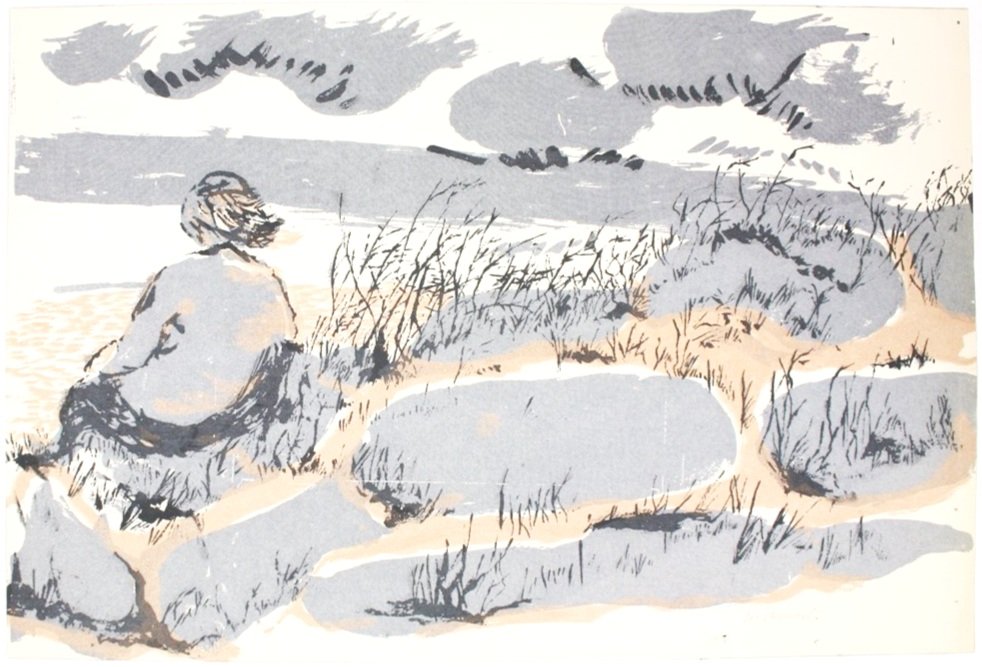What is a collection’s freeze (and why did we do it?)
Screenprint of figure seated on rocky shore. JPL Archives, Joseph Prezament Fonds, ID: 1360_[3]_137.
I have been wrestling with implementing a collections freeze since I became the Director of Archives in late 2020. I’ve put one into effect this year until April 2026. Here is why I’ve made the difficult decision.
Over the years the JPL Archives has acquired archival collections thanks to the passionate collecting activities of JPL Directors, private collectors, Jewish institutions, and not least thanks to Archivist Emeritus Eiran Harris and former Archives Directors, Jessica Zimmerman and Shannon Hodge. For such a small organization, the JPL’s archival collecting has been prolific.
When I arrived in 2020, every surface of the archives was covered in archival materials. There simply wasn’t room for new acquisitions! Processes of digitization and inventorying were underway everywhere. Nonetheless, only 50% of the archives’ holdings were fully processed and available for research. Backlogs aren’t strange in archives; archival processes are labour intensive and take time. Still, accepting archival materials comes with commitments to donors that their materials will be preserved and made accessible. It’s important to honour these commitments before taking on more. Case in point, a conversation with a colleague at the National Library of Israel in that same year revealed that the NLI does not accept archival materials unless they can ensure that they can process them within two years.
Accepting material sets off incredibly time and labour-intensive processes for an archives. These are the major steps the archivist(s) will take:
Prior to accepting materials, researches the proposed donation
Sets up appointment with donor to review materials (on or off-site) and makes preliminary selection decisions
Drafts an inventory to accompany the donor agreement
Prepares donor agreement outlining conditions of use for signing
Coordinates the transfer of material and prepares a receipt of transfer for signing
Starts the secondary stage of appraisal – reviewing materials in depth, weeding out duplicates and non-archival items.
Arranges materials to foster ease of findability by researchers
Preserves materials through rehousing in acid-free containers
Labels folders with unique codes and describes their contents in the online catalogue
Conducts research to enrich descriptions and link them with related materials
Digitizes a representational selection and links digital assets to the catalogue
Works with donor on making any necessary updates to ensure accuracy
Moshe Shaffir in the Jewish Public Library working through the Reuben Brainin Archives. 1944. JPL Archives, Photograph Collection. ID: 1255_PR011705
However, before you engage in any of these processes, you need the space to house collections. So, for over four years, I have worked tirelessly to reclaim space in our climate-controlled storage and processing room. I have transferred materials that do not comply with our collections mandate to other departments and institutions; dispersed fine art and artefacts throughout the library for display purposes; worked with other departments to reduce the footprint of their materials in our stacks. It helped secure space for a number of new acquisitions.
But the issue of fulfilling donor commitments remained. Our commitment to donors to 1) preserve and 2) make accessible their materials is fittingly the archivist’s professional creed. It was clear that my department of one would not be able to make large inroads on the sizable work ahead. I turned to fundraising. With the collaboration of JPL’s Director of Development, Kimberly Tepperman, the JPL Archives received the largest grant in the institution’s history. Funding from the Azrieli Foundation supplied the Archives the means to hire a full staff complement. We have worked hard to reduce the backlog by 5% annually, migrate our database to cloud-based industry-standard software, improve reference services, and share our collections through outreach and programming.
Unfortunately, the funding is finite. Though I continue to devote substantial time to fundraising, in the coming year or so, the JPL may resume its archival department of one. For this reason, there is renewed urgency for the existing team to focus on the appraisal, preservation and description of existing archival donations before accepting more. And focusing on processing now will have positive effects for the future:
It helps us gain clarity on what we hold so we can avoid duplication in future collecting
Appraisal and preservation processes tend to shrink collections and make more room for others. Why? Appraisal entails removing copies and non-archival materials and preservation can entail reboxing materials into space-saving containers.
There are so many processes that are undertaken between the initial collecting of materials to when they are made accessible to the public. By prioritizing collecting without yet having the means to appraise, preserve and describe materials online, my predecessors responded to what was most urgent – saving historic materials from the landfill. They had faith that one day in the future the archives would have the means to pursue the other processes required. In honour of all those that came before me, I think the future is now.
We extend a sincere thank-you for your patience and understanding.
If you want to donate materials and are wondering, ‘what now?’ Here are two steps you can take:
If waiting for April 2026 is feasible, you are welcomed to fill out the JPL Archives intake form and we will be in touch once the hiatus is done.
If a donation is urgent, you may wish to contact another collecting organization. Find Jewish archival and heritage organizations at this CJHN resource.


